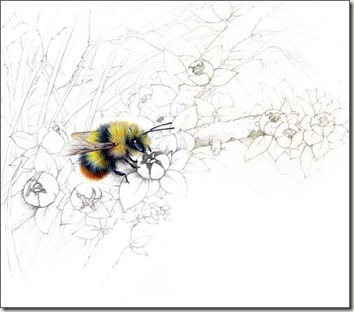In my box of bee “models”, which have proved to be so surprisingly popular at my Buzz shows, I have a little family.
It’s a Bombus pratorum trio; the queen, little fluffy male and a tiny neat worker. If anyone is frightened of bees, learning about this endearing family usually does the trick. The males are particularly attractive and they were all over the cotoneaster in the churchyard here last year, so I chose the male for this set of paintings.
They are also delightfully hairy, with long silky hair which sticks up here and there. There’s a bit of a rakish air about them, quite different from the short haired B lapidarius who looks like a piece of velvet.
They are also a lemony yellow, not the orange yellow of Bombus terrestris. Laura at Bumblebee.org. (just the nicest bumblebee site on the net) says this:
“Once a male has left the nest he does not return. His sole aim is to mate, and he will patrol a circuit laying down a scent at strategic spots in order to attract a newly emerged queen who will find the scent so irresistible that she will allow him to mate with her. The only other thing he does is drink nectar. So he will stay outside all night, usually clinging to the underside of a flower for some protection from rain etc. Often he will choose the same flower night after night. Then once the morning sun comes out he has just enough strength to climb – in the UK they are often too cold to fly – up to the flower entrance to drink some nectar and warm up ready for more scent patrolling.”
The tiny, fluffy, Bombus pratorum on cotoneaster,
Watercolour and pencil on Arches HP.







Interesting information. I wonder if most bumbles found "sleeping" in the garden in the early morning are males out on their own. ct
So perfectly fluffy! I love how well you capture the essence of the bees. They look like they could easily fly right off the page.
Beautiful – you have captured the fluffiness and the shiny eyes superbly!